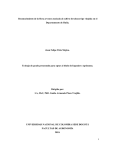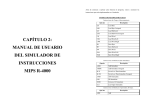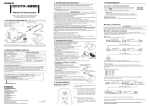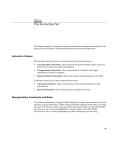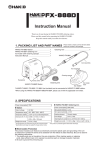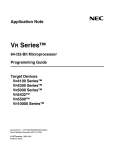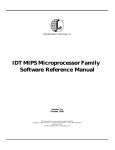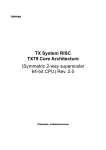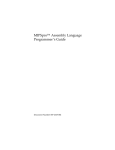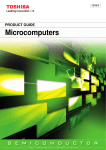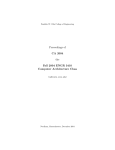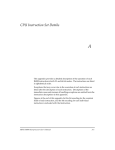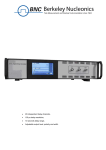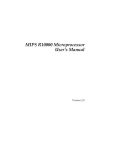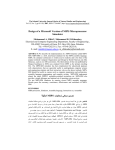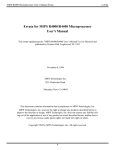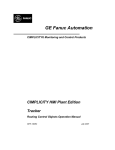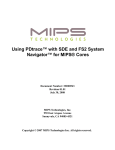Download 64-bit Extension to MIPS ISA
Transcript
64-bit Extension to MIPS ISA CSE 3322 Term Paper Fall 1999 Name : Student ID : Login ID : Submitted : Nov 8, 1999 64-bit Extension to MIPS ISA 1.0 Abstract MIPS (Microprocessor without Interlocked Pipe Stages) is a general-purpose processor architecture, based on the RISC philosophy and is designed to be implemented on a single VLSI chip. The 64-bit extension to the MIPS 32-bit ISA, was first implemented in the 3rd generation R4000 family of processors. This paper describes the key features of this ISA extension. 2.0 Introduction 2.1 Extension to an ISA An Extension to an existing ISA simply means adding new instructions or features that allow significant advances in performance. Extensions could be application specific (e.g. for digital media processing applications), customer specific (e.g. 32-bit multiply-accumulate instruction), industry specific etc. First of all, a clear distinction between architecture and implementation of that architecture needs to be made. Application architecture refers to the instruction set, the physical components and timing, etc., to which all hardware implementations must adhere, and to which applications must limit themselves, e.g., MIPS I, MIPS II, MIPS MDMX etc. Implementation refers to specific hardware designs using the architecture, e.g., the R-Series (R2000, R3000, R4000, R6000, etc). Of these, the MIPS R4000 processor onwards, extends the architecture to 64 bits – the integer registers and ALU are 64 bits wide, and linear, 64-bit virtual addressing is available, when the 64-bit mode is enabled. (It is the first microprocessor to provide this capability as was shipped in 1991.) The relationship between the MIPS ISA and its extensions can be represented as follows: MIPS Extended ISA MIPS ISA Fig 1.1 Extensions to the ISA 2 2.2 64-bit Systems There are three fundamental requirements a computer system must meet, to be called a 64-bit system. Firstly, it must have a processor that efficiently supports 64-bit data types including pointers. This implies the primary data paths for the system is (at least) 64-bits wide. Secondly, there must be a compilation system that can produce 64-bit executables. And the last requirement is an operating system that can run 64-bit programs. Thus, it is plain that formulating the 64-bit ISA, is a first step towards building 64-bit systems. The emerging applications in the digital consumer market are handheld and palm PCs, set-top boxes, Web TV, and satellite receivers. The common need in these applications is finding ways to move data efficiently. According to MIPS Technologies co-founder John Hennessy, “That’s where a 64-bit RISC architecture gives you an overwhelming advantage because it provides the bandwidth you need….. The growth in the level of performance will be much faster in embedded systems than in general desktop machines.” The first highvolume consumer product to use a 64-bit RISC architecture was the Nintendo-64 video player, which is based on the MIPS R4000 microprocessor! 3.0 A Historical Perspective The MIPS architecture originated with the MIPS I ISA, the R2000 being the first microprocessor designed and shipped in the last week of 1985. Till date, this architecture has been extended in a backward compatible fashion four times. MIPS II extended MIPS I by providing 32 registers, for double precision math and adding instructions to give. As applications required 64-bit addressing and data capability, MIPS III added 64-bit data handling instructions. As processors became faster due to advances in fabrication and technology, memory latency became a bottleneck; also, 3-D visualization demanded more floating-point (FP) performance. MIPS IV added new instructions to boost performance in these areas. In recent years, however, the huge explosion of 32-bit and 64-bit processors in embedded and consumer applications and the requirement of supporting 3D, video, audio have led to the development of more super-set architectures, like MIPS V for 3D applications and MDMX for digital media. Another application specific extension is also defined, for cost-sensitive embedded and consumer applications, MIPS16, announced jointly by LSI Logic Corporation and MIPS Technologies Inc. are 16-bit instructions geared for having compressed code. These 16-bit instructions use a lot less memory while providing the functionality required for the embedded market. Table 1 below, [ref1] summarizes the history of the different ISAs and their respective year of release. 3 Table 1 - Year of implementation of MIPS processors ISA Year Processors that Implemented ISA Announced MIPS I 1984 R2000, R3000 MIPS II 1990 R6000 MIPS III 1991 R4000, R4200, R4300i, R4400, R4600, R4700 MIPS IV 1994 R5000, R8000, R10000 (superscalar processors) MIPS V MDMX MIPS16 1996 1996 1996 TBA TBA LSI Logic Tiny RISC 4.0 Hardware Requirements for the 64-bit ISA The MIPS64 architecture is a superset of the previous MIPS IV and MIPSV Instruction Set Architectures (ISAs) and incorporates powerful new instructions specifically for embedded applications as well as proven memory management and privileged mode control mechanisms. To provide backward compatibility, every implementation supports two addressing modes. The processor's addressing mode determines whether it generates 32-bit or 64-bit memory addresses. It incorporates the best features of previous 32- and 64-bit MIPS processors, focusing on DSP, data-streaming, embedded applications, and floating-point arithmetic. MIPS64 is based on a fixed-length, regularly encoded instruction set, and it uses a load/store data model. It is streamlined to support optimized execution of highlevel languages. Arithmetic and logic operations use a three-operand format, similar to the core ISA, allowing compilers to optimize complex expressions formulation. 4.1 Processor Resources The CPU provides sixty-four 64-bit wide registers in any MIPS64 implementation. Thirty-two of these registers, referred to as General Purpose registers (GPR’s) are reserved for integer operations, while the other thirty-two registers, referred to as Floating Point General Purpose Registers (FGR’s), are reserved for floating point operations. The width of these registers depends on the mode of operation. In 32-bit mode, they are treated as 32 bits wide. In 64-bit mode, they are treated as 64 bits wide. In the 32-bit ISA, the FPU has 16 floating-point registers. Each register can hold either a single-precision (32-bit) or double-precision (64-bit) value. In case of a double-precision value, $f0 holds the least-significant half, and $f1 holds the 4 most-significant half. All references to these registers in a 32-bit architecture, use an even register number (for example,$f4, $f8…). But in MIPS64, one can reference all 32 registers directly. Table 2 summarizes the usage conventions and restrictions for these registers. Table 2 – Names and Usage conventions of FGR’s in MIPS64 & MIPS 32. Register Name in MIPS64 ISA Corresponding MIPS32 Name Use and Linkage $f0, $f2 $f0..$f2 Hold results of floating-point type function $f1, $f3, $f4..$f11 $f4..$f10 $f12..$f19 $f12..$f14 $f20..$f23 $f16..$f18 Temporary registers, used for expression evaluation; their values are not preserved across procedure calls. Pass single or double precision actual arguments, whose values are not preserved across procedure calls Temporary registers, used for expression evaluation; their values are not preserved across procedure calls. $f24..$f31 $f20..$f30 Saved registers, whose values must be preserved across procedure calls. In addition there are a minimum of 6 special purpose registers - PC (program counter), HI and LO, floating point implementation and control registers FCR0 and FCR31 and a LOAD/LINK (LL) bit. However, unlike MIPS32, in MIPS64 architecture, the PC, HI and LO registers are 64-bits wide. Appendix 1 illustrates this. Also, in addition to a 64-bit on-chip FPU, 64-bit integer ALU and 64-bit integer registers, a processor implementing the MIPS 64-bit architecture should also provide 64-bit virtual address spaces and a minimum of a 64-bit system bus. 4.2 Data Formats MIPS64 defines a 64-bit double-word, a 32-bit word, 16-bit half-word and an 8-bit byte. The byte ordering is configurable in either Big-endian or Little-endian format, depending on the implementation. e.g. R4300i uses the Little-Endian, and most of the mainstream processors use Big-Endian. MIPS64 uses 32-bit addressing and 64-bit data. 5 Data formats are to be used to specify addresses. MIPS CPUs use a byteaddressing scheme. Access to half-words requires alignment on even byte boundaries, and access to words requires alignment on byte boundaries that are divisible by four. Access to double words (for 64-bit systems) requires alignment on byte boundaries that are divisible by eight. In general, any attempt to address a data item that does not have the proper alignment ( except for “unaligned” load and store instructions) causes an alignment exception, which is then handled by the appropriate operating system exception service routine. 4.3 Memory Management Unit The MMU of an implementation can deploy a Translation Lookup Buffer (TLB) or a Block Address Translation (BAT) as a virtual-to-physical address translation mechanism, with the TLB being the most popular. Mapped virtual addresses are translated into physical addresses using an on-chip TLB1. Designated System Control Coprocessor (CP0) registers provide the software interface to the TLB. The processor virtual address can be either 32 or 64 bits wide, depending on whether the processor is operating in 32-bit or 64-bit mode. • In 32-bit mode, addresses are 32 bits wide. The maximum user process size is 2GB (231) • In 64-bit mode, addresses are 64 bits wide. The maximum user process size is 1 terabyte (240). A 32-bit address space can be restrictive for some of today's large database, engineering, and scientific programs. The 2 GB usable main memory provided to applications, may not be enough for data intensive applications. A 64-bit address space may increase data base performance by permitting a huge data cache. A 64-bit engineering or scientific simulation permits problems to be solved that would otherwise be too large for a 32-bit address space. The down side of such an advantage is that 64-bit programs have secondary costs that may increase their memory and cache requirements compared to a 32-bit version. Because pointers are represented as 64-bit values, the memory to store pointers will double. 64-bit operating systems are very likely to support 64bit file systems. Some application areas like geophysics and particle physics may require file sizes well in excess of two gigabytes (the general limit for 32-bit file systems). While 64-bit pointers are manipulated as 64-bit quantities, in the foreseeable future no machine will use this entire range which could address 16 billion gigabytes of data. Thus, MIPS64 uses 32-bit addressing and 64-bit data. 1 On-chip TLB’s have been implemented in most of the mainstream implementations, including R4400, R10000 and R8000. 6 4.4 Operating Modes There exist three operating modes, in which a system implementing the ISA could operate. These modes, in order of decreasing system privilege are: • • • Kernel mode (highest system privilege): can access and change any register. The innermost core of the operating system runs in kernel mode Supervisor mode: has fewer privileges and is used for less critical sections of the operating system. User mode (lowest system privilege): prevents users from interfering with one another. Selection between the three modes can be made by the operating system (when in Kernel mode) by writing into Status register's KSU field. The processor is forced into Kernel mode when the processor is handling an error (the ERL bit is set) or an exception (the EXL bit is set). Appendix 2 shows how the selection of operating modes, instruction sets and addressing modes are implemented in R10000, by enabling the Status register's appropriate fields. 4.5 Other Issues The architecture derives the privileged mode exception handling and memory management functions from the R4000 and R5000 class processors, which implemented the MIPS II & III. A set of registers reflects the configuration of the caches, MMU, TLB, and other privileged features implemented in each core. The flexibility of high-performance caches and memory management schemes is a strong feature of the MIPS architecture. The MIPS64 architecture extends this advantage with well-defined cache control options. The size of the instruction and data caches can range from 256 bytes to 4Mbytes. The data cache can employ either a write-back or write-through policy. A no-cache option can also be specified. With all these features, MIPS 64 is an ISA tailor-made for heavy-duty data-crunching applications. 5.0 Instruction Classes In addition to the core instructions of the MIPS32 ISA, each of the instruction classes have been enriched with new instructions to improve performance. The five instruction classes of MIPS 64 are similar to MIPS 32 and are given below. 1. Data Transfer – Load and store Instructions 7 2. Computational – Arithmetic and logical operations 3. Jump and Branch Instructions – Change flow of control. 4. Coprocessor Interface - These instructions provide standard interfaces to the co-processors. 5. Special Instructions - These instructions do miscellaneous tasks. The most significant instructions of the 64-bit extension in each instruction class have been dealt with in each of the sections below. 5.1 Extensions to the Data Transfer Instructions As in MIPS32, load and store are immediate type instructions that move data between memory and the general registers. However, in MIPS64 instructions are needed to handle 64-bit data. The additional instructions to do this are listed in Appendix 3. However, the two very significant integer instructions, which set MIPS64 apart are Load Linked and Store Conditional. They provide the mechanism for implementing interprocessor or intertask synchronization primitives, such as Test-and-Set and Compare-and-Swap. MIPS 64 architecture also interlocks load instructions, so if an instruction attempts to use data loaded by the immediately preceding instruction, the pipeline will stall. In MIPS 32, however, such an attempt will produce an incorrect result, and a no-op instruction must be added after load unless a useful instruction not depending on the load can be placed there. The MIPS 64 allows the no-ops to be eliminated. The Load linked instruction operates as a standard load instruction but has the side effect of setting the “link” status bit2. As a part of the cache coherency mechanism, the processor monitors accesses to the linked location and clears the link status bit if another processor accesses that location. Store Conditional performs a store operation only if the link bit is set, and it provides a register in the destination register indicating if the store was successful. The two instructions, combined with the hardware mechanism that controls the link status bit, allow indivisible test-and-set and other semaphore operations to be implemented without requiring bus locks. Apart from these two instructions, the Pre-Fetch Instruction also is important. The "Prefetch" instruction supplies an address and hint to the implementation about the data. Hints include whether the data is likely to be read or written soon, likely to be read or written only once, or likely to be read or written many times. Prefetch does not cause exceptions. This instruction is also used in conjunction with Branch Likely . 2 The Link status bit is a single bit special purpose register. Refer to Appendix 2. 8 5.2 Extensions to the Computational Instructions There are general-purpose and coprocessor-specific( e.g., the floating-point coprocessor) computational instructions. Computational instructions perform arithmetic, logical, shift, Multiply and divide operations on register values. Fixed-point DSP-type (Digital Signal Processing) instructions further enhances multimedia processing. These instructions that include Multiply (MUL), Multiply and Add (MADD), Multiply and Subtract (MSUB), and "count leading 0s/1s," previously available only on some 64-bit MIPS processors, provide greater performance in processing data streams such as audio, video, and multimedia without adding additional DSP hardware to the system. All the Arithmetic operations that were supported by the MIPS 32 ISA, have been extended to operate on 64-bit registers. A comprehensive list, along with description is provided in Appendix 4. However, two of the most significant instructions, which have enhanced efficiency in MIPS64 for handling FP as well as integers are shown in table 3. Table 3 – MADD and MSUB instructions Instruction Operands Description MADD MSUB 1. 2. 3. 4. destination, src1, src2, src3 1.destination, 2. src1, 3. src2, 4. src3 Multiply the contents of src2 and src3, then add the result to src1 and store in the destination register (MADD). The NMADD instruction does the same multiply then add, but then negates the sign of the result (This instruction is for 64-bit values only) Multiply the contents of src2 and src3, then subtract the result from src1 and store in the destination register (MSUB). The NMSUB instruction does the same multiply then subtract, but then negates the sign of the result (This instruction is for 64-bit values only) 5.3 Jump and Branch Instructions Jump and branch instructions change the flow of a program. The MIPS 64 ISA adds conditional Traps and special branch instructions called “likely” to the core instructions. They are tabulated in Appendix 5. 9 The actual execution order depends on the processor's organization; in a typical pipelined processor, instructions are executed only in program order. That is, the next sequential instruction may begin execution during the next cycle, if all of its operands are valid. Otherwise, the pipeline stalls until the operands do become valid. Since instructions execute in order, stalls usually delay all subsequent instructions. A clever compiler can improve performance by re-arranging instructions to reduce the frequency of these stall cycles. Although one or more instructions may begin execution during each cycle, each instruction takes several (or many) cycles to complete. Thus, when a branch instruction is decoded, its branch condition may not yet be known, as it requires more information, which will only be available, some time in the future. For faster execution however, the processor can predict whether the branch is taken, and then continue decoding and executing subsequent instructions along the predicted path. When a branch prediction is wrong, the processor must back up to the original branch and take the other path. This technique is called speculative execution. Whenever the processor discovers a wrongly predicted branch, it aborts all speculatively executed instructions and restores the processor's state to the state it held before the branch. (Side effects, for e.g., the Cache State not being restored, is possible; but because cache coherency is maintained, side-effects are harmless in these operations) Branch prediction can be controlled by the CP0 Diagnostic register. Branch Likely instructions are always predicted as taken, which also means the instruction in the delay slot of the Branch Likely instruction will always be speculatively executed. Since the branch predictor is neither used nor updated by branch-likely instructions, these instructions do not affect the prediction of "normal", i.e. the usual conditional branches. Thus, Branch Likely Instructions are the same as an ordinary branch instruction (without the "Likely"), except in a branch likely instruction, the instruction in the delay slot is nullified if the conditional branch is not taken. 5.4 Coprocessor Interface The Floating-Point Unit is the hardware implementation of Coprocessor 1 in the MIPS IV Instruction Set Architecture. However, depending on the application and functionality of the processor, the coprocessor unit could be designed as MDMX, etc.. The MIPS ISA defines 32 logical floating-point general registers (FGRs), as mentioned in section 4.1, above. Each FGR is 64 bits wide and can hold either 32-bit single-precision or 64-bit double-precision values. In R10000, the hardware actually contains 64 physical 64-bit registers in the Floating-Point Register File, from which the 32 logical registers are taken. 10 The MIPS64 ISA, supports a floating-point condition code register and also optional paired single-precision floating-point instruction execution (SIMD). 5.5 Special Instructions The main processor’s special instructions do miscellaneous tasks. Though most of the following instructions are available in MIPS32, they are a part of the extension in MIPS64. 1. Break (BREAK) Unconditionally transfers control to the exception handler. The breakcode operand is interpreted by software conventions. The breakcode1 operand is used to fill the low-order 10 bits of the 20-bit immediate field in the BREAK instruction. The optional second operand, breakcode2 fills the high-order 10 bits. 2. Exception Return (ERET) Returns from an interrupt, exception or error trap. Similar to a branch or jump instruction, ERET executes the next instruction before taking effect. (In place of RFE in MIPS32) 3. Move From HI Register (MFHI) Moves the contents of the HI register to a general-purpose register. Move From LO Register (MFLO) Moves the contents of the LO register to a general-purpose register. 4. Move To HI Register (MTHI) Moves the contents of a general-purpose register to the HI register. Move To LO Register (MTLO) Moves the contents of a general-purpose register to the LO register. 5. Syscall (SYSCALL) causes a system call trap. The operating system interprets the information set in registers to determine what system call to do. 6.0 Applications of the MIPS64 ISA Machines with implementation of the 64-bit ISA can operate on data in 64-bit chunks instead of 32-bit. This results in more efficient processing and permit programs to utilize huge virtual address spaces. Thus, systems can be designed to handle enormous files far in excess of two gigabytes. The move to 64-bit makes workstations more like traditional supercomputers. 64-bit systems make true supercomputing and hugely data intensive applications feasible on computers that are more like conventional workstations than highly specialized and expensive supercomputers. Moreover, 64-bit systems are opening up new computing possibilities, for e.g., huge-scale databases with sophisticated query engines, real-time video services and faster and lifelike picture quality. 11 MIPS64 compatible 64-bit MIPS processors are well suited for applications requiring very high-performance RISC processing and compact, system-on-achip (SOC) implementations3. Some of the areas in which MIPS64 is currently used are: Portable Computing Systems • • Handheld and Palm-size PCs including Windows CE Applications Information Appliances Network Management • • • Routers Switches xDSL systems Digital Consumer Devices • • Game Platforms – like the Nintendo 64, Arcade games etc. Set-top Boxes – for web TV applications Office Automation • • • • Printers Copiers Scanners Multifunction Peripherals Other • • • • • Industrial Controllers Automotive Systems Navigation (GPS) – military uses Graphics Systems Dedicated Terminals(POS, ATM, e-cash) 7.0 Conclusion The megabillion-dollar computer market is always changing. An explosion of communications technology fueled by the availability of inexpensive and increasingly powerful RISC microprocessors is leading to increasing use of embedded computers. Despite the millions of PCs shipped every year, computers account for less than 10 percent of the total market of microprocessor and microcontroller chips. In January, 1999, NEC and Toshiba, two of the world’s leading chip makers, acquired 64-bit RISC IP by securing 10-year licenses for MIPS Technologies’ Ruby processor4. Ruby, which will be the industry’s first 64-bit RISC to hit 1 3 4 From reference 12 From reference 5 12 billion instructions per second, will serve as an engine for intelligent consumer devices, including set-top boxes, entertainment products, handheld devices, Internet appliances, and data communications equipment. The 10-year agreements are proof that 64-bit applications are real. Thus, new classes of computer-based devices appear in the market every day. Most will affect our lives in ways ranging from fun (Nintendo video games) to significant (like palm top PC’s) to awesome (GPS mapping for computers in new cars). Behind all this is the MIPS ISA, providing us with the power to efficiently design complex systems. 13 References 1. MIPS RISC Architecture; Kane, Gerry and Heinrich, Joe; Prentice Hall 1992; STL QA 76.8.M52K36 1992 2. A Guide to RISC Microprocessors; Slater, Michael; Academic Press; 1992; pp. 146-155; STK TK 7895.M5 G85 1992 3. Is your X code ready for 64-bit? - Mark J. Kilgard; Silicon Graphics Inc.; Oct 1997, http://reality.sgi.com/opengl/64bit/64bit.html 4. MIPSpro Assembly Language Programmer's Guide, MIPS Publications, Document # 007-2418-001, (http://www.mips.com/publications/index.html) 5. An Interview with John Henessey, Embedded Processor Solutions- A special issue of Silicon Strategies, Sept, 99 - http://www.s2mag.com/eps/ 6. MIPS R4000 Microprocessor User’s Manual; Second Edition; Heinrich, Joe, MIPS Technologies Publication, 1994. 7. Design of the R8000 Microprocessor, Peter Yan-Tek Hsu, MIPS Technologies, (http://www.sgi.com/processors/r8000/design/r8000.html#intro) 8.Computer Architecture: Case Studies; Baron, Robert J. and Higbie, Lee; Addison-Wesley; 1992; pp. 223-232; STL QA 76.9.A73 B3733 9. MIPS V Instruction Set, 1996, Silicon Graphics (http://www.sgi.com/MIPS/arch/ISA5/#MIPSV_indx). 10.Survey of RISC Architectures; Web Extension I; Computer Organization and Design: The Hardware/Software Interface, Second Edition; (COD:HSI 2e), by Patterson, David A. and Hennessy, John L. ; (ftp://ftp.mkp.com/COD2e/Web_Extensions/survey.htm#I.6) 11. Introduction to MIPS V, Silicon Graphics(http://www.sgi.com/MIPS/arch/ISA5) 12. Product brief on MIPS64 Architecture; MIPS Technologies; (http://www.mips.com/products/s2p2.html) 14 Appendix 1 - Special Purpose Registers – MIPS 64 ISA Program Counter (PC) | 63 32 | 31 PC 0| Multiply/Divide Registers | 63 32 | 31 MultHI 0| MultLO Floating Point Registers : Impl/Rev (FCR0) & Control/Status (FCR31) | 31 0| FCR0 FCR31 Load Linked bit 0 15 Appendix 2 - Implementation of Operating and addressing modes in R10000 The R10000 has three operating modes and two addressing modes. The three operating modes, in order of decreasing system privilege are: • Kernel mode (highest system privilege): can access and change any register. The innermost core of the operating system runs in kernel mode • Supervisor mode: has fewer privileges and is used for less critical sections of the operating system. • User mode (lowest system privilege): prevents users from interfering with one another. Selection between the three modes can be made by the operating system (when in Kernel mode) by writing into Status register's KSU field. The processor is forced into Kernel mode when the processor is handling an error (the ERL bit is set) or an exception (the EXL bit is set). Table 16-1 shows the selection of operating modes with respect to the KSU, EXL and ERL bits. It also shows how different instruction sets and addressing modes are enabled by the Status register's XX, UX, SX and KX bits. The R10000 processor was designed for use with the MIPS IV ISA; however, for compatibility with earlier machines, the useable ISAs can be limited to either MIPS III or MIPSI/II. Table 16-1 Processor Modes The processor's addressing mode determines whether it generates 32-bit or 64-bit memory addresses. • • • In Kernel mode the KX bit allows 64-bit addressing; all instructions are always valid. In Supervisor mode, the SX bit allows 64-bit addressing and the MIPSIII instructions. MIPS IV ISA is enabled all the time in Supervisor mode. In User mode, the UX bit allows 64-bit addressing and the MIPS III instructions; the XX bit allows the new MIPS IV instructions. ------------ 16 Appendix 3 - Load/Store Instructions for MIPS 64 Extended ISA. 1. Load Doubleword (LD) Loads the destination register with the contents of the doubleword that is at the memory location. The system replaces all bytes of the register with the contents of the loaded doubleword. The system signals an address error exception when the effective address is not divisible by eight. 2. Load Linked Doubleword (LLD) Loads the destination register with the contents of the doubleword that is currently in the memory location. This instruction performs a SYNC operation implicitly. Load Linked Doubleword and Store Conditional Doubleword can be used to update memory locations atomically. 3. Load Word Unsigned (LWU) Loads the least-significant bits of the destination register with the contents of the word (32 bits) that is at the memory location specified by the effective address. Because the system treats the loaded word as an unsigned value, it fills the four most-significant bytes of the destination register with zeros. If the effective address is not divisible by four, the system signals an address error exception. 4. Load Doubleword Left (LDL) Loads the destination register with the mostsignificant bytes of the doubleword specified by the effective address. The effective address must specify the byte containing the sign. In a big-endian configuration, the effective address specifies the lowest numbered byte; in a little-endian machine, the effective address specifies the highest numbered byte. Only the bytes which share the same aligned doubleword in memory are merged into the destination register. 5. Load Doubleword Right (LDR) Loads the destination register with the leastsignificant bytes of the doubleword specified by the effective address. The effective address must specify the byte containing the least-significant bits. In a bid-endian machine, the effective address specifies the highest numbered byte. In a little-endian machine, the effective address specifies the lowest numbered byte. Only the bytes which share the same aligned doubleword in memory are merged into the destination register. 6. Unaligned Load Doubleword (ULD) Loads a doubleword into the destination register from the specified address. ULD loads a doubleword regardless of the doubleword’s alignment in memory. 7. Store Conditional (SC) Stores the contents of a word from the source register into the memory location specified by the effective address. This instruction implicitly performs a SYNC operation; all loads and stores to shared memory fetched prior to the SC must access memory before the SC, and loads and stores to shared memory fetched subsequent to the SC must access memory after the sc. If any other processor or device has modified the physical address since the time of the previous Load Linked instruction, or if an ERET (Exception Return) instruction occurs between the Load Linked and this store instruction, the store fails. The success or failure of the store operation (as defined above) is indicated by the contents of the source register after execution of the instruction. A successful store sets it to 1; and a failed store sets it to 0. The machine signals an address exception when the effective address is not divisible by eight. 17 8. Store Doubleword (SD) Stores the contents of a doubleword from the source register in the memory location specified by the effective address. The effective address must be divisible by eight, otherwise the machine signals an address error exception. 9. Store Conditional Doubleword (SCD) Stores the contents of a doubleword from the source register into the memory locations specified by the effective address. This instruction implicitly performs a SYNC operation. If any other processor or device has modified the physical address since the time of the previous Load Linked instruction, or if an ERET instruction occurs between the Load Linked instruction and this store instruction, the store fails and is inhibited from taking place. The success or failure of the store operation (as defined above) is indicated by the contents of the source register after execution of this instruction. A successful store sets it to 1; and a failed store sets it to 0. The machine signals an address exception when the effective address is not divisible by eight. 10. Store Doubleword Left (SDL) Stores the most-significant bytes of a doubleword in the memory location specified by the effective address. It alters only the doubleword in memory which contains the byte indicated by the effective address. 11. Store Doubleword Right (SDR) Stores the least-significant bytes of a doubleword in the memory location specified by the effective address. It alters only the doubleword in memory which contains the byte indicated by the effective address. 12. Unaligned Store Doubleword (USD) Stores the contents of the source register in a doubleword specified by the address. The machine does not require alignment for the storage address. 18 Appendix 4 - Computational Instructions for MIPS 64 Extended ISA 1. Doubleword Absolute Value (DABS) Computes the absolute value of the contents of src1, treated as a 64-bit signed value, and puts the result in the destination register. If the value in src1 is –2147483648, the machine signals an overflow exception. 2. Doubleword Add with Overflow (DADD) Computes the twos-complement sum of two 64-bit signed values. The instruction adds the contents of src1 to the contents of src2, or it can add the contents of src1 to the immediate value. When the result cannot be extended as a 64-bit number, the system signals an overflow exception. 3. Doubleword Add without Overflow (DADDU) Computes the twos- complement sum of two 64-bit values. The instruction adds the contents of src1 to the contents of src2, or it can add the contents of src1 to the immediate value. Overflow exceptions never occur. 4. Doubleword Divide Signed (DDIV) Computes the quotient of two 64-bit values. DDIV treats src1 as the dividend. The divisor can be src2 or the immediate value. It puts the quotient in the destination register. If the divisor is zero, the system signals an error and may issue a BREAK instruction. The DDIV instruction rounds towards zero. Overflow is signaled when dividing –2147483648 by -1. Note: The special case DDIV $0,src1,src2 generates the real doubleword divide instruction and leaves the result in the HI/LO register. The HI register contains the quotient. No checking for divide-by-zero is performed. 5. Doubleword Divide Unsigned (DDIVU) Computes the quotient of two unsigned 64bit values. DDIVU treats src1 as the dividend. The divisor can be src2 or the immediate value. It puts the quotient in the destination register. If the divisor is zero, the system signals an exception and may issue a BREAK instruction. See note for DDIV concerning $0 as a destination. Overflow exceptions never occur. 6. Doubleword Multiply (DMUL) Computes the product of two values. This instruction puts the 64-bit product of src1 and src2, or the 64-bit product of src1 and the immediate value, in the destination register.Overflow is not reported. Note: Use DMUL when you do not need overflow protection. It is often faster than DMULO and DMULOU. For multiplication by a constant, the DMUL instruction produces faster machine instruction sequences than DMULT or DMULTU can produce. 7. Doubleword Multiply (DMULT) Computes the 128-bit product of two 64-bit signed values. This instruction multiplies the contents of src1 by the contents of src2 and puts the result in the HI and LO registers. No overflow is possible. 8. Doubleword Multiply Unsigned (DMULTU) Computes the product of two unsigned 64-bit values. It multiplies the contents of src1 and the contents of src2, putting the result in the HI and LO registers. No overflow is possible. 9. Doubleword Multiply with Overflow (DMULO) Computes the product of two 64-bit signed values. It puts the 64-bit product of src1 and src2, or the 64-bit product of src1 and the immediate value, in the destination register. When an overflow occurs, the system signals an overflow exception and may execute a BREAK instruction 10. Doubleword Multiply with Overflow Unsigned (DMULOU) Computes the product of two 64-bit unsigned values. It puts the 64-bit product of src1 and src2, or the 64-bit product of src1 and the immediate value, into the destination register. When an overflow occurs, the system signals an overflow exception and may issue a BREAK instruction. 11. Doubleword Negate with Overflow (DNEG) Computes the negative of a 64- bit value. The instruction negates the contents of src1 and puts the result in the 19 destination register. If the value of src1 is –2147483648, the system signals an overflow exception. 12. Doubleword Negate without Overflow (DNEGU) Negates the 64-bit contents of src1 and puts the result in the destination register. Overflow is not reported. 13. Doubleword Remainder Signed (DREM) Computes the remainder of the division of two signed 64-bit values. It treats src1 as the dividend. The divisor can be src2 or the immediate value. The DREMU instruction puts the remainder in the destination register. If the divisor is zero, the system signals an error and may issue a BREAK instruction. 14. Doubleword Remainder Unsigned (DREMU) Computes the remainder of the division of two unsigned 64-bit values. It treats src1 as the dividend. The divisor can be src2 or the immediate value. The DREMU instruction puts the remainder in the destination register. If the divisor is zero, the system signals an error and may issue a BREAK instruction. 15. Doubleword Rotate Left (DROL) Rotates the contents of a 64-bit register left (towards the sign bit). This instruction inserts in the least-significant bit any bits that were shifted out of the sign bit. The contents of src1 specify the value to shift, and contents of src2 (or the immediate value) specify the amount to shift. If src2 (or the immediate value) is greater than 63, src1 shifts by src2 MOD 64. 16. Doubleword Rotate Right (DROR) Rotates the contents of a 63-bit register right (towards the least-significant bit). This instruction inserts in the sign bit any bits that were shifted out of the least-significant bit. The contents of src1 specify the value to shift, and the contents of src2 (or the immediate value) specify the amount to shift. If src2 or the immediate value is greater than 63, src1 shifts by src2 MOD 64. 17. Doubleword Shift Left Logical (DSLL) Shifts the contents of a 64-bit register left (towards the sign bit) and inserts zeros at the least-significant bit. The contents of src1 specify the value to shift, and the contents of src2 (or the immediate value) specify the amount to shift. If src2 (or the immediate value) is greater than 63, src1 shifts by src2 MOD 64. 18. Doubleword Shift Right Arithmetic (DSRA) Shifts the contents of a 64-bit register right (towards the least-significant bit) and inserts the sign bit at the most-significant bit. The contents of src2 (or the immediate value) specify the amount to shift. If src2 (or the immediate value) is greater than 63, src1 shifts by src2 MOD 64. 19. Doubleword Shift Right Logical (DSRL) Shifts the contents of a 64-bit register right (towards the least-significant bit) and inserts zeros at the most-significant bit. The contents of src1 specify the value to shift, and the contents of src2 (or the immediate value) specify the amount to shift. If src2 (or the immediate value) is greater than 63, src1 shifts by src2 MOD 64. 20. Doubleword Subtract with Overflow (DSUB) Computes the twos-complement difference for two signed 64-bit values. This instruction subtracts the contents of src2 from the contents of src1, or it can subtract the immediate value from the contents of src1. It puts the result in the destination register. When the true result’s sign differs from the destination register’s sign, the system signals an overflow exception. 21. Doubleword Subtract without Overflow (DSUBU) Computes the twos complement difference for two unsigned 64-bit values. This instruction subtracts the contents of src2 from the contents of src1, or it can subtract the immediate value from the contents of src1. It puts the result in the destination register. Overflow exceptions never happen. 20 Appendix 5 - Branch Likely Instructions in MIPS 64 Description OpCode Operand Branch on Equal Likely BEQL src1,src2,label Branch on Greater Than Likely Branch on Greater/Equal Likely Branch on Greater/Equal Unsigned Likely Branch on Greater Than Unsigned Likely Branch on Less Than Likely Branch on Less/Equal Likely Branch on Less/Equal Unsigned Likely Branch on Less Than Unsigned Likely Branch on Not Equal Likely Branch on Equal to Zero Likely Branch on Greater/Equal Zero Likely Branch on Greater Than Zero Likely Branch on Greater or Equal to Zero and Link Likely Branch on Less Than Zero and Link Likely Branch on Less/Equal Zero Likely Branch on Less Than Zero Likely Branch on Not Equal to Zero Likely BGTL src1, immediate, label BGEL src1, immediate, label BGEUL src1, immediate, label BGTUL src1, immediate, label BLTL src1, immediate, label BLEL src1, immediate, label BLEUL src1, immediate, label BLTUL src1, immediate, label BNEL src1, immediate, label BEQZL src1,label BGEZL src1,label BGTZL src1,label BGEZALL src1,label BLTZALL src1,label BLEZL src1,label BLTZL src1,label BNEZL src1,label 21






















